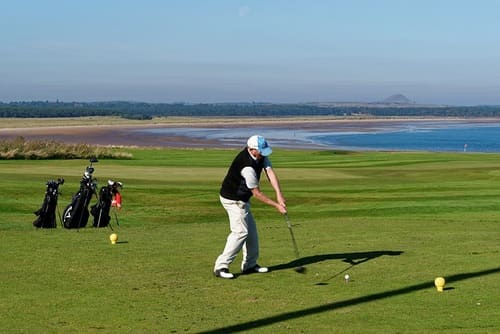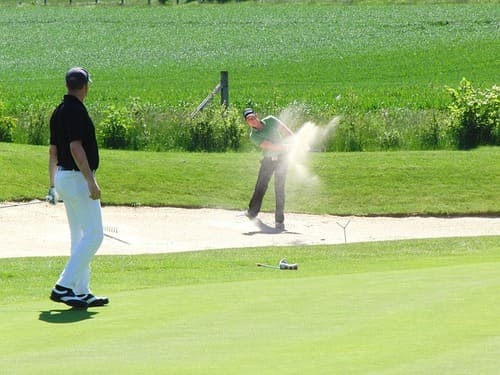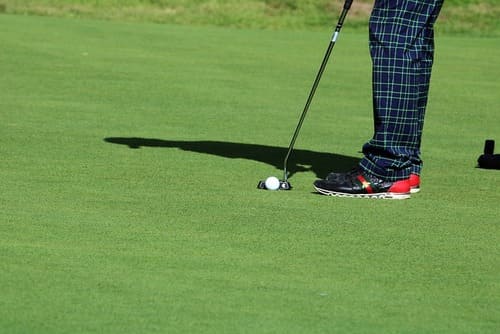Picture this: you’re standing on the pristine greens, driver in hand, ready to take a swing at that tiny white ball, which seems like it’s miles away. You give it your best shot, and the ball gracefully soars into the sky, making a perfect arc before landing on the fairway. The sun is shining, the birds are singing, and you feel like a golfing prodigy. But, if you’re like most of us, reality might be a little less cinematic. But how long does it take to get good at golf?
So, just how long does it take to transform from a golfing novice into a true maestro of the greens? Grab your putter and join us as we embark on an enchanting journey to uncover the secret recipe for golfing greatness. It’s time to tee off on the quest to answer that age-old question.
The Basics of Golfing Skills
Golf is a sport that attracts millions of enthusiasts around the world. It is a game that combines precision, strategy, and physical endurance. At its core, golfing skills are about achieving accuracy and control in every shot.
One of the first things beginners need to grasp is the grip. The grip is how a golfer holds the club, and it directly affects the swing and the trajectory of the ball. Another fundamental aspect is the stance. The proper stance provides a stable foundation and allows the body to move in sync with the swing. Finally, posture is crucial in maintaining balance and alignment throughout the swing. By mastering these basics, beginners can lay a solid foundation for their golfing skills.
The Importance of Consistent Practice
Consistent practice is the cornerstone of improving your golfing skills. Without regular and structured practice sessions, it is difficult to develop the necessary muscle memory and maintain a consistent swing. When it comes to golf, repetition is key. By consistently practicing your swing, you can reinforce proper mechanics and build confidence in your abilities.
Moreover, consistent practice allows you to identify and correct any weaknesses in your game. Whether it’s working on your short game or perfecting your long shots, regular practice sessions provide an opportunity to focus on specific areas that need improvement. By dedicating consistent time to practicing different aspects of your game, you can fine-tune your skills and address any weaknesses that may be holding you back on the course. Remember, practice doesn’t just make perfect; it makes progress.
Learning the Fundamentals: Grip, Stance, and Posture
Grip, stance, and posture are the foundational elements in golf that can greatly influence your swing and overall performance on the course. When it comes to grip, it’s important to find a comfortable and natural position that allows you to have control over the club. The two most common grip types are the overlapping grip and the interlocking grip, but it ultimately depends on what feels best for you. A proper grip not only ensures a secure hold on the club but also promotes consistency in your shots.
Alongside a correct grip, maintaining a proper stance is essential for maximizing power and accuracy in your swing. Your feet should be shoulder-width apart, with a slight bend in your knees to help generate power from the ground up. Balance is crucial, so distribute your weight evenly between both feet.
Additionally, make sure your upper body is relaxed and slightly tilted forward from the hips. This posture enables better rotation and balance throughout your swing. By mastering the fundamentals of grip, stance, and posture, you lay the groundwork for a solid and effective golf swing.

Understanding the Golf Swing: Mechanics and Techniques
To master the game of golf, understanding the mechanics and techniques of the golf swing is crucial. The golf swing is a complex combination of movements that require precision and coordination. The grip, stance, and posture play an integral role in executing a successful swing.
The grip is how the golfer holds the club, and it greatly impacts the control and power generated during the swing. It is important to have a neutral grip, where the hands are positioned comfortably on the club with the palms facing each other. The stance refers to the positioning of the feet, shoulder-width apart, with the weight evenly distributed. Lastly, the posture involves maintaining a straight spine with a slight bend at the waist and knees. These fundamental elements work together to provide a solid foundation for an effective swing.
Developing a Solid Short Game: Putting, Chipping, and Pitching
Developing a solid short game is crucial for any golfer looking to improve their overall performance on the course. Putting, chipping, and pitching are the key elements that make up this particular aspect of the game.
Putting is often considered one of the most important skills in golf, as it can make or break a round. The goal is to roll the ball smoothly along the green and into the hole, utilizing precise aim and distance control. To develop a solid putting game, golfers should focus on adopting a consistent stance and grip, as well as maintaining a smooth and rhythmic stroke. Regular practice on the putting green is essential to hone these skills and to build confidence when faced with those challenging short putts.
Chipping and pitching, on the other hand, come into play when golfers find themselves closer to the green but not quite within putting range. These shots demand a different set of skills, as they require more precision and touch. Golfers must learn how to control the trajectory, spin, and roll of the ball to get it as close to the hole as possible.
It is essential to practice different types of chip shots, such as bump-and-run shots or high lob shots, to develop versatility around the green. This will ultimately allow golfers to confidently navigate various lies and conditions, ensuring they can make the most out of every scoring opportunity.
Building Distance and Accuracy with Irons and Woods
To build distance and accuracy with irons and woods in golf, it is crucial to focus on the fundamentals of the swing and develop a solid technique. One of the key aspects to consider is the grip. Ensuring a proper grip on the club allows for maximum control and power during the swing. It is important to find a grip that feels comfortable and natural, while also providing sufficient control over the clubface. Additionally, mastering a balanced and athletic stance is essential. By maintaining a stable base and distributing weight evenly, golfers can generate more power and maintain better control throughout the swing.
Another crucial element to building distance and accuracy with irons and woods is understanding the mechanics of the swing. The golf swing involves a combination of upper body rotation, wrist hinge, and weight transfer. It is important to practice a consistent swing tempo and rhythm, as this can contribute to better timing and more consistent ball striking. Developing a smooth and fluid swing motion will result in better clubhead speed and, consequently, increased distance.
Furthermore, understanding the proper technique for each club, such as the angle of attack and the position of the clubface at impact, can greatly improve accuracy and ball flight control. By focusing on these essential aspects, golfers can enhance their ability to hit long and accurate shots with their irons and woods.
Mastering Specialty Shots: Bunker Play and Trouble Shots
One of the most challenging aspects of the game of golf is mastering specialty shots that come with unique demands. Bunker play and trouble shots require precise technique and strategic thinking to navigate the hazards and keep the ball on track. These shots can often make or break a player’s round, making it essential to develop the skills needed to handle them confidently and effectively.
Bunker play involves hitting the ball out of a sand trap and requires a different approach than shots on the fairway. The key to successful bunker play is a combination of technique and the right mindset. Players need to focus on hitting the sand behind the ball to create the necessary lift and produce the desired result. Rehearsing the correct stroke and practicing different bunker scenarios can help build confidence and improve consistency in this challenging aspect of the game.
Similarly, trouble shots refer to situations where the ball is in a difficult position, such as being stuck behind a tree or sitting on an uneven lie. These shots demand creativity and adaptability, as players must carefully assess the surroundings and adjust their setup and swing accordingly. It is crucial to remain calm and composed during these situations, as hasty decision-making can often lead to further trouble. By practicing different trouble shots and learning how to think strategically, golfers can enhance their ability to handle these challenging scenarios and minimize potential setbacks in their gameplay.

The Role of Physical Fitness in Golf Improvement
Physical fitness plays a crucial role in improving one’s golf game. Engaging in regular exercise can improve strength, flexibility, and stamina, all of which are essential for performing well on the golf course. Strengthening the core muscles, such as the abdominals and lower back, can help generate more power and stability during the swing.
Additionally, developing flexibility in the shoulders, hips, and hamstrings allows for a greater range of motion, leading to smoother and more efficient swings. Lastly, improving cardiovascular endurance through activities like jogging or cycling helps golfers maintain focus and energy levels throughout the round.
Incorporating a well-rounded fitness routine also helps prevent injury in golf. The repetitive nature of the game, coupled with the torque and forces exerted on the body during the swing, can put strain on various muscles and joints. By building strength and flexibility in the right areas, golfers can minimize the risk of common injuries, such as back pain or elbow strain.
Furthermore, a strong and resilient body can recover faster from minor injuries, enabling golfers to continue their practice and play without prolonged interruptions. Overall, prioritizing physical fitness is not only beneficial for improving performance but also for ensuring longevity and enjoyment in the game.
Mental Game: Strategies for Focus, Concentration, and Confidence
One of the key factors in improving your golf game is honing your mental skills. A strong mental game can make a significant difference in your overall performance on the course. Strategies for focus, concentration, and confidence can help you stay calm under pressure, maintain a positive mindset, and make better decisions during your rounds.
To enhance your focus, it’s important to stay present and avoid getting distracted by external factors. Clear your mind, breathe deeply, and focus on the task at hand. Additionally, building a pre-shot routine can help you get into the right frame of mind before every shot. By consistently repeating this routine, you can train your mind to enter a state of heightened concentration and focus.
Confidence is also crucial in golf. Believing in your abilities and trusting your swing can greatly impact your performance. Practice positive self-talk and visualize successful shots to boost your confidence levels. Remember that golf is a game of highs and lows, and maintaining confidence during challenging moments can make a significant difference in your overall game. By implementing these strategies for focus, concentration, and confidence, you can elevate your mental game and improve your golf performance.
Setting Realistic Expectations and Goals for Golf Improvement
Whether you are a beginner or an experienced golfer, setting realistic expectations and goals is crucial for your improvement in the game. It is important to recognize that golf is a challenging sport that requires time, effort, and patience to master. Setting unrealistic expectations can lead to frustration and disappointment, while setting achievable goals can provide you with a sense of accomplishment and motivation to keep pushing forward.
When setting goals for golf improvement, it is essential to consider your current skill level, time availability, and commitment to practice. It is unrealistic to expect overnight success or to become a professional golfer in a short span of time. Instead, focus on setting small, achievable goals that will help you gradually improve your skills and overall performance.
For example, aim to reduce your number of putts per round or increase the accuracy of your tee shots by a certain percentage. By breaking down your goals into smaller milestones, you can track your progress and celebrate your achievements along the way. Remember, golf is a lifelong journey, and improvement takes time and dedication.

FAQs
How long does it take to improve golfing skills?
The time it takes to improve golfing skills can vary depending on the individual. However, it is important to remember that improvement is a gradual process and consistent practice is key. It may take several months or even years to see significant improvement in your game.
What are the fundamentals that I should focus on when starting to learn golf?
When starting to learn golf, it is essential to focus on the fundamentals such as grip, stance, and posture. These elements provide a foundation for a solid swing and overall technique. Taking the time to master these basics will greatly contribute to your improvement as a golfer.
How can I improve my short game?
To improve your short game, it is crucial to practice putting, chipping, and pitching. These skills require precision and finesse, and consistent practice is necessary to develop them. Utilizing various drills and techniques can help improve your touch and control around the greens.
What should I do to increase distance and accuracy with my irons and woods?
Increasing distance and accuracy with your irons and woods involves a combination of proper technique, timing, and practice. Working on your swing mechanics, maintaining good balance, and developing a consistent tempo are key factors in achieving better results with these clubs.
How can I master bunker play and trouble shots?
Mastering bunker play and trouble shots requires practice and understanding of the techniques involved. Learning proper sand shot technique, understanding how to navigate different lies, and developing a variety of shots will help you confidently handle challenging situations on the course.
What role does physical fitness play in golf improvement?
Physical fitness plays a significant role in golf improvement. Improving flexibility, strength, and overall fitness can enhance your swing mechanics, increase power, and reduce the risk of injury. Incorporating exercises specifically designed for golfers into your routine can have a positive impact on your game.
How can I improve my mental game in golf?
Improving your mental game in golf involves strategies for focus, concentration, and confidence. Techniques such as visualization, positive self-talk, and pre-shot routines can help you stay focused and confident throughout your round. Mental discipline and practice are key to developing a strong mental game.
How do I set realistic expectations and goals for golf improvement?
Setting realistic expectations and goals for golf improvement involves assessing your current skill level, understanding your time commitment, and being aware of your limitations. It is important to set specific, measurable, achievable, relevant, and time-bound (SMART) goals that align with your abilities and available resources. It is also important to be patient with yourself and celebrate incremental progress along the way.






